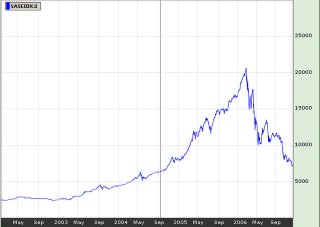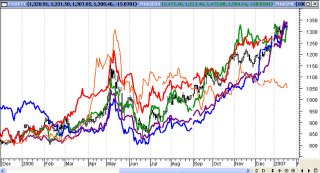``Throughout all my years of investing I've found that the big money was never made in the buying or the selling. The big money was made in the waiting.” Jesse Livermore
As I’ve noted in the past, markets are mainly emotionally driven, despite the thought that we act rationally in its face, the painful truth is...we don’t. Since markets are hardly about equilibrium, as they constantly change, expectations can be overestimated in the short run and underestimated over the long run. In short, nothing is fixed everything is fluid and dynamic, governed by expectations.
Irrationality means that we are hardwired to frequently use “rules of thumb” or mental short-cuts in our thought processes particularly in decision making, often falling into traps of cognitive biases. Recency or Anchoring biases, overconfidence, rationalization, framing, loss aversion, regret theory are part of such “cognitive illusions” or the illusions of knowing.
There is also the phenomenon called as the “emergence”. Josh Wolfe of Forbes describes it as, ``Emergence is a fancy way of saying that the whole is greater than the some of the parts. Ant colonies, brains, cities, behavior in markets all exhibit this phenomenon of emergence where the constituent components give rise to higher order.” Put differently once we attain a certain level we tend to seek more.
And seeking more is what news headlines are all about these days as analysts pile atop each other declaring the bullish outlook for the Phisix “Philippines one of Asia’s top 3 investment sites” or “Stock prices seen rising further in ’07”.
As I have said in the past, market tops are usually characterized by “euphoria” and global markets including the Phisix could go vertical or parabolic before “topping out”. Let make a recent example of Saudi Arabia’s Tadawul All share index as shown in Figure 4.

Figure 4: Bloomberg: Saudi Arabia’s Tadawul All Share Index
As you can see in the chart, the final phase or “blow out top” of the Tadawul Index was marked by a nearly 90° ascent.
From about 2,500 to a little over 20,000, the Tadawul index leapt by nearly 7 times in three years before the harrowing collapse of late. Today, it drifts at around the 7,000 levels which essentially translate to over 60% of losses from the peak, in spite of the supposed intervention by Saudi’s Prince Alwaleed bin Talal. The scale of correction is almost equal and opposite to the degree of the trend that preceded it. The Lesson: The higher and the faster the rise, the steeper and harder the fall.
Of course, the structural dynamics of Saudi’s Tadawul is starkly different than the Phisix, of which the latter has followed closely the movements of major Global indices. Another is that the pace of volatility has not been as dramatic as that of Saudi’s bourse which had only 78 issues of publicly listed companies. Lastly, the financial market dynamics has been more “regional” oriented, the Phisix and Philippine asset class in general has had more correlation with the financial asset classes of its neighbors.
This is not to even suggest that the Phisix will do a Tadawul. The lessons are clear no trend goes in a straight line. Even the Philippine cycle shows the same patterns.
During the Phisix’s last bullmarket cycle which was from 1986 until 1997, the Philippine benchmark encountered two major mid-cycle corrections, triggered by the failed coup attempts of 1987 and 1989 as shown in Figure 5 (arrows).
Figure 5: Phisix: Reviewing the Last Bull cycle
Yes, the Phisix flew by over 10 (read my lips T-E-N!) times before the massive correction took place in 1987. And in both instances, the Phisix gave up over 50% of its gains during these mid-cycle retracements which lasted by about a year each.
As stated above, market trend dynamics are never linear.
Today, the Phisix has gained by only about 200% from its low in 2002, which makes its current advances relatively inferior compared to the Tadawul and Phisix 1986 experience to merit the same degree of horrifying adjustments.
In other words, if the Phisix should correct in tandem with global markets, I do not expect the same extent of damage seen in our previous examples.
 Figure 6: Phisix subsectors: Mines Diverge
Figure 6: Phisix subsectors: Mines DivergeAs for industry specifics, if one where to assess on the recent actions of the market, the mines and the general market moved independently of each other in 2006, which makes a worthwhile case for portfolio diversification, see Figure 6.
The mining index (orange line) took the first semester by storm, while severely underperforming the second semester rally by a big margin against the broadmarket issues.
This means that while it is possible for mines to diverge with the general market even when the PHISIX corrects, given the narrow breadth of our underdeveloped market, the opposite case of the rising tide lifts all boats could also occur. As Edwin Lefevre wrote, ``In a bull market, all stocks go up. In a bear market all stocks go down...in a general sense.” I think this applies especially to less advanced and sophisticated markets as ours.
Well, candidly, I wouldn’t exactly know how the market would turnout when a correction transpires. Sorry, but I have no predictive powers of a clairvoyant, unlike some of my contemporaries. Instead, I heed the advices of the battletested and successful investment or fund managers as the legendary John Templeton, who said ``The best time to invest is when you have money. This is because history suggests it is not timing which matters, it is time.”
And based on time, in the context of market cycles and probabilities, since I think we are in a secular long term bullmarket, positioning gradually based on how the market progresses or how the interim cyclicality unfold should make one’s returns at least at par with the index.
Over the short-term, I think the Phisix as well as most global markets are in high-risk low-return sphere. I would rather be cautious and selective. Be careful out there.




1 comment:
benson:
Cant agree with you more on the effects of sitting tight. i made many reallocation errors in order to chase quicker yields in the past -- only to end up with a total net portfolio return less than if i held on as is.
Notice your wishlist of books. I was fortunate enough to grab a copy of Kurzweil's book a few years ago. Its quite compelling although some of his ideas come across as..well, dated, given the media coverage of new technology. But his AI futurist stance may be a reality in a century or so.
AS for the other titles, am looking at Ferguson's Cash Nexus. I have heard good reviews of the book you mentioned.
Post a Comment